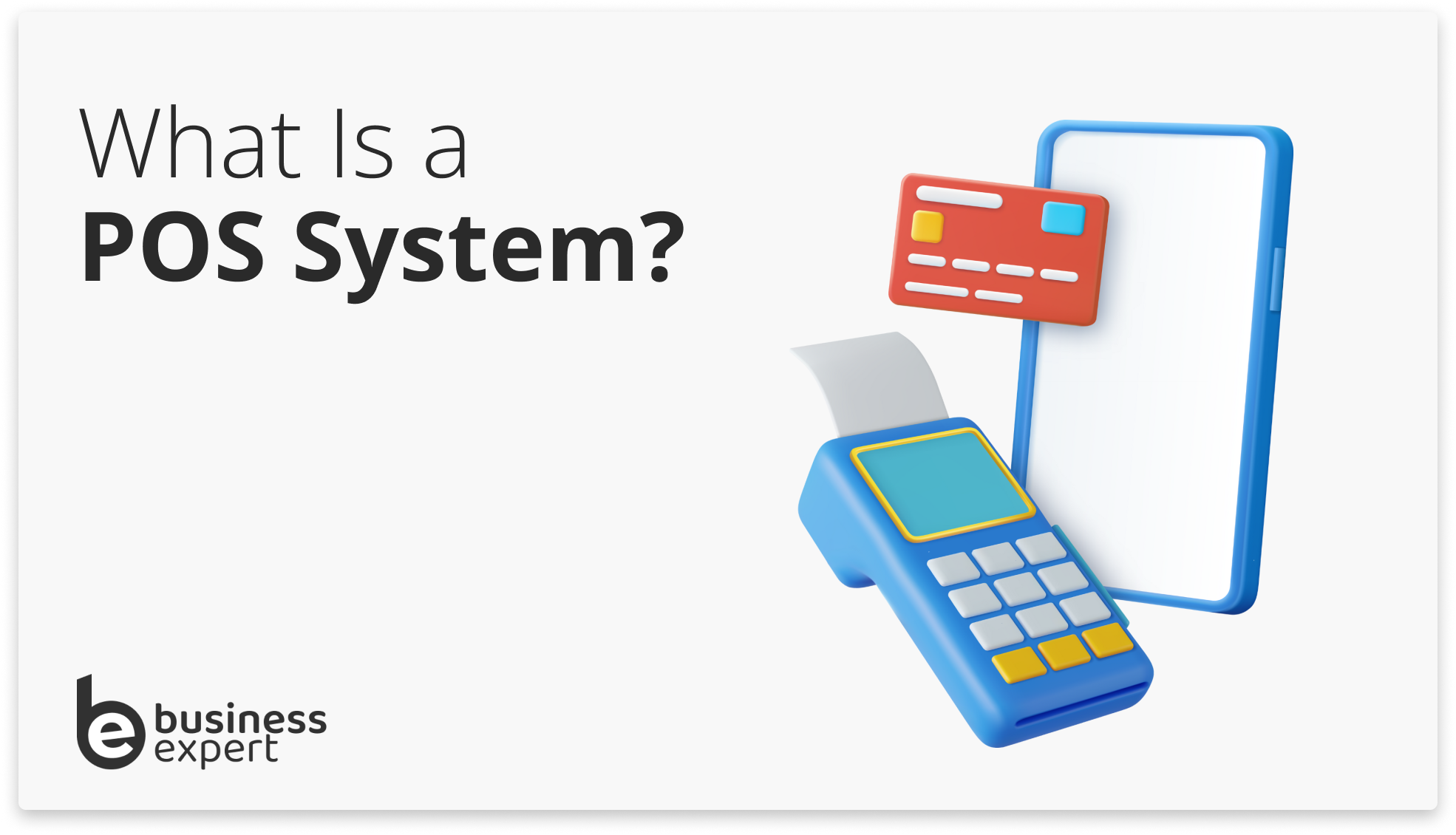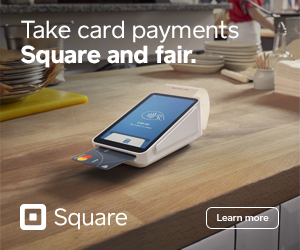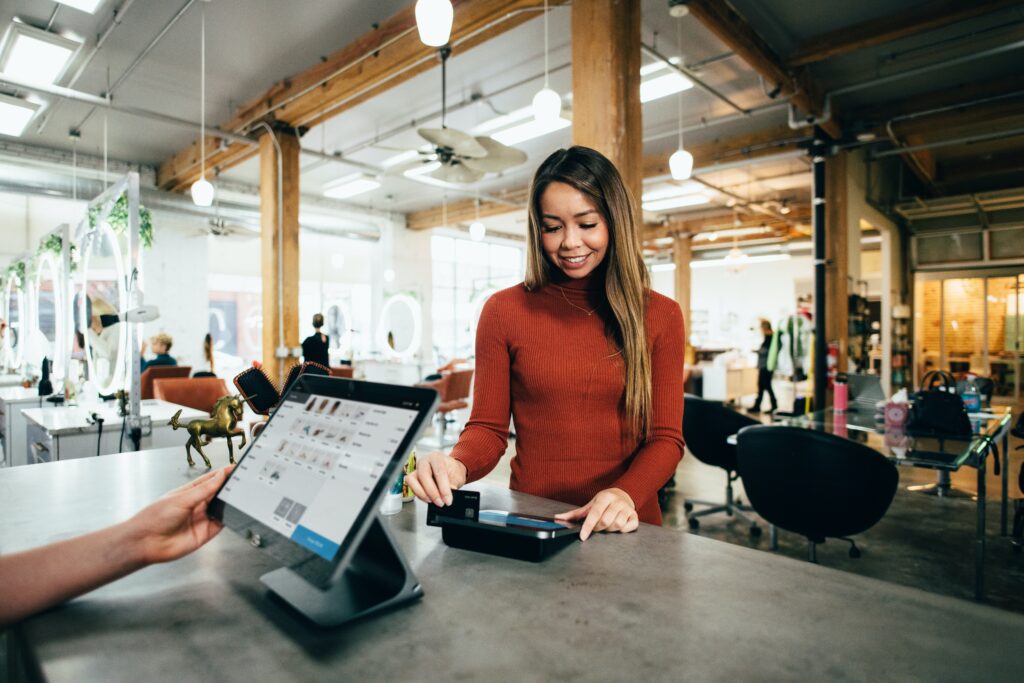There are over three million Point of Sale (POS) systems in the UK, processing over 62.5 billion transactions.per year.
But what exactly is a POS or EPOS, and how does it work?
» MORE Read our full article on The Best Card Machines for Small Business


What is a POS System?
A POS (Point of Sale) system is an integrated set of hardware and software designed specifically for the purpose of managing sales transactions. It enables merchants to accept payments, manage customer purchases, and issue receipts directly at the point of sale. This comprehensive system includes devices such as computers or tablets, scanners, cash drawers, receipt printers, and card readers, alongside software for processing transactions, tracking inventory, and analyzing sales data.

Traditional POS systems were primarily used in brick-and-mortar stores and consisted of a cash register and basic accounting software. Modern POS systems, on the other hand, are multi-functional. They are fully digital, leveraging sophisticated software to handle inventory management, customer relationship management and sales analytics, in addition to facilitating payments.
Unlike traditional systems, modern POS systems can operate on a variety of hardware platforms, from specialized POS terminals to third-party smartphones. Cloud-based options have further democratized the marketplace, making it simpler for small businesses to adopt powerful, data-driven systems.
The scalability and adaptability of contemporary POS systems make them invaluable assets for businesses across sectors. From single-outlet stores to sprawling retail chains and from e-commerce to service providers, a tailored POS system can significantly enhance operational efficiency and customer satisfaction.
» MORE Read our full article on Best POS Systems for Restaurants
How Does a POS System Work?
A POS system operates by accurately calculating the total amount due for a customer’s purchase, incorporating any applicable sales tax, and facilitating the payment process. It also records the transaction’s specifics, including the time and date. Following the completion of a sale, the system is capable of generating both paper and digital receipts while simultaneously updating the inventory records to reflect the sale.
Here’s what they can do:
Payment Processing
POS systems accept various payment forms, including cash, debit and credit cards, and digital wallets. The system processes the payment and updates the customer’s account accordingly.
Inventory Management
POS systems track inventory levels in real-time. When a customer purchases an item, the system updates the inventory level accordingly. This helps businesses to ensure that they have enough stock on hand and to avoid overselling.
Customer Relationship Management
POS systems can collect customer data, such as contact information, purchase history, and preferences. This data can be used to create targeted marketing campaigns and loyalty programs.
Employee Management
POS systems can track employee hours, sales performance, and task assignments. This data can be used to improve employee productivity and customer service.
Sales Analytics
POS systems can generate detailed sales reports that provide insights into customer behavior, product performance, and business trends. This data can be used to make informed business decisions.
Cross-Channel Consistency
POS systems can synchronize data across multiple channels, such as physical stores, online shops, and mobile apps. This ensures that customers have a seamless experience regardless of how they choose to shop.

POS Hardware
POS hardware refers to the physical components and devices used in a point of sale system to facilitate sales transactions. These hardware components are essential for the operation of the POS system, enabling the processing of payments, scanning of items, and issuance of receipts.
Key POS hardware components include:
- Register or Terminal: This is the computerized replacement for a cash register and serves as the central hub where sales are processed.
- Credit Card Reader: A crucial device for authorizing and processing card payments, whether that’s through magnetic stripe cards, chip cards, or contactless methods.
- Barcode Scanner: Speeds up the checkout process by quickly providing information about the product, such as price and stock level.
- Cash Drawer: A secure compartment for storing cash received from transactions. Modern cash drawers are electronically connected to the POS system for improved cash management.
- Receipt Printer: Provides physical proof of transaction for customers, and can also serve in record-keeping and bookkeeping processes.
POS Software
POS software is the program that runs on a computer or tablet at the point of sale, handling the sale process by recording transactions, managing inventory, and processing payments. It connects to devices like scanners and printers to help businesses track sales, update stock levels, and provide receipts.
It will include some or all of the following:
- Payment Processing Software: The heart of any POS system, it enables the processing of multiple types of payments securely and efficiently.
- Inventory Management Software: This feature automates the tedious task of stock-keeping, making it easier to manage, reorder, and audit inventory.
- Customer Relationship Management (CRM) Software: Captures customer data and interaction history, facilitating targeted marketing and service customization.
- Employee Management Software: Helps in time-tracking and productivity assessment, often providing functionality for task allocation and role-based access control.
- Analytics and Reporting Software: Collects and analyses sales and other operational data to provide actionable insights for informed decision-making.
Payment processing services
Payment processing services facilitate the secure transfer of funds from a customer’s bank account or credit card to the merchant’s account, making transactions smooth and efficient.
They allow businesses to accept a wide range of payment methods, including debit cards, credit cards, contactless payments (such as NFC technology), and mobile wallet payments (like Apple Pay and Google Wallet). Payment processing services also integrate with POS software, ensuring that payment information is accurately captured and reflected in sales records and inventory management.
How much does a POS system cost?
Deciding to implement a POS system requires a careful assessment of potential costs, aiming to strike a balance between a solution that facilitates growth and operational efficiency and one that aligns with your current budget and business complexity.
POS Hardware Costs
On the more accessible end of the spectrum, a basic setup like the Square Reader can be purchased for as low as £19. This device, which connects to your smartphone, offers fundamental POS capabilities, enabling businesses to start processing payments with minimal investment and without any contractual ties.
For businesses in the retail or hospitality industries requiring a more sophisticated system, hardware costs can significantly increase. A full POS terminal setup, including devices such as a computer or tablet, cash drawer, receipt printer, and card reader, can range from £200 to £1,000 per terminal. This variation in cost reflects the diversity in hardware specifications, from basic to advanced features tailored to different business needs.
POS Software Costs
Beyond hardware, POS software licensing is another crucial factor in the overall cost. Software subscription fees can vary, typically costing between £100 to £300 annually. This fee covers the user license for the POS software, which includes sales processing, inventory management, customer data handling, and analytics.
Additionally, businesses might incur costs for installation and training, which can range from £100 to £300. These fees are for setting up the system and training staff on how to use it effectively. Some providers might include these services within the initial package, while others charge separately.
Payment Processing Fees
Typically, payment processing fees range from 0.4% to 3.5% per transaction. The exact rate can depend on several factors, including whether the payment is made via debit or credit card, the card issuer, and whether the transaction is considered “card-present” (swiped, tapped, or inserted) or “card-not-present” (online or over the phone). For instance, credit card transactions often incur higher fees than debit card transactions and card-not-present transactions usually have higher rates due to the increased risk of fraud.
It’s important for businesses to carefully consider these processing fees when choosing a POS system and payment processing service, as they can significantly impact overall costs, especially for businesses with a high volume of transactions. Negotiating rates with processors or choosing a payment service that offers competitive rates can help manage these costs and protect profit margins.
How POS Systems Tackle Business Operational Issues
Operating a business with a POS system is not merely about completing transactions; it’s about integrating various aspects of your operation into a unified, streamlined process. A sophisticated POS system goes beyond the cash register functionality, serving as the nerve centre of your business.
To begin with, inventory management becomes considerably more efficient. Real-time tracking ensures you’re neither overstocked nor understocked, optimising your capital usage. Furthermore, automated reorder points and reports save administrative time that can be better used elsewhere.
Your POS system can also harmonise the sales and marketing functions. Through targeted promotions and discounts, which can be programmed directly into the system, you ensure that marketing efforts are instantly implementable at the point of sale. The system can also handle multi-channel sales, thereby unifying your in-store and online offerings.
Then there’s staff management, which is often an overlooked functionality. Modern POS systems offer time-tracking and role-based permissions. This not only improves accountability but also simplifies the payroll process.
Lastly, the system can offer actionable analytics, from sales reports to customer behaviour, which can guide strategic planning. This data-driven approach can be a game-changer in achieving competitive advantage.
How a POS System Can Improve Customer Engagement
A point-of-sale (POS) system can act as more than just a transactional interface; it can serve as a potent tool for enhancing customer engagement. By centralising customer data, the system can offer critical insights into consumer behaviour, preferences, and spending patterns.
For instance, loyalty programmes can be effortlessly integrated into your POS system. These programmes encourage repeat business by offering rewards or discounts tailored to customer data. This enables a more personalised shopping experience, which in turn fosters customer loyalty.
Similarly, gift cards and vouchers can be easily managed, giving customers a convenient gifting option while driving incremental sales. With your POS system, these can be issued, redeemed, and managed seamlessly, reducing administrative hassle.
Email marketing is another area where a POS system can add value. Most systems have the capability to capture customer email addresses at the point of sale. This database can then be used for sending targeted promotions or newsletters, which are more likely to be well-received when they are based on actual purchase history.
A noteworthy benefit of using a POS system for customer engagement is the speed and efficiency it brings to customer service. Returns, exchanges, and queries can be handled swiftly, thanks to the easy access to transaction histories and customer information. This convenience is not only beneficial for the customer but also reduces the time staff spend on administrative tasks.
How A POS Can Help With Employee Management
Managing a team effectively is paramount for any business aiming for longevity and success. In this context, a POS system serves as a multi-faceted tool that can simplify workforce management considerably. From task delegation to performance monitoring, modern POS systems offer an array of features that facilitate efficient staff administration.
Clocking in and out of shifts can be managed directly through the POS interface. By integrating this functionality into the system, businesses can maintain accurate records of employee hours, thereby streamlining the payroll process. Importantly, this feature minimises the opportunity for manual errors, which can lead to payroll discrepancies and subsequent disputes.
Furthermore, a POS system can act as a hub for task management. Assignments related to inventory restocking, customer service, or any other operational aspect can be distributed through the system. This digital delegation method enhances accountability, as tasks can be monitored for completion status, thereby creating a data-driven approach to employee performance evaluation.
POS System Security and Compliance
Ensuring the security of your POS system is crucial for protecting your business and customer data. A high-quality POS system will come with built-in security features, such as encryption for transactional data, to keep unauthorized parties from accessing sensitive information. Keeping your software up to date is key to defending against emerging cyber threats.
Your POS system should also help you with compliance. For example, it should assist with tax calculations and reporting to make sure your business aligns with relevant laws. Some systems offer audit trails, providing a record of all activities, useful for internal reviews and regulatory requirements.
Here are some key factors to consider when choosing a POS system:
- Feature set: Make a list of the features that are most important to your business. This may include things like inventory tracking, customer relationship management (CRM), staff management, and reporting.
- Integration: Choose a POS system that can integrate with your existing business software, such as your accounting system and e-commerce platform. This will help to streamline your operations and reduce manual data entry.
- Scalability: Choose a POS system that can scale with your business. As your business grows, you need a system that can grow with it.
- Price: POS systems can range in price from a few hundred dollars to several thousand dollars. Choose a system that fits your budget and needs.
